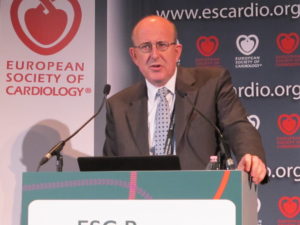
ENSURE-AF, the largest prospective, randomised clinical trial to date of anticoagulation for electrical cardioversion in non-valvular atrial fibrillation, has shown that edoxaban is an effective and safe alternative to vitamin K antagonists (VKAs) for the prevention of stroke and other blood clot complications in this setting.
The study, presented by principal investigator Andreas Goette (St Vincenz-Hospital Paderborn, Germany) at a Hot Line session of the European Society of Cardiology Congress (ESC; 27‒31 August, Rome, Italy), also found that edoxaban (Lixiana/Savaysa, Daiichi Sankyo) may allow prompt cardioversion to be performed following the start of anticoagulation within two hours with a transesophageal echocardiography (TEE)-guided strategy and three weeks without TEE.
Current guidelines recommend three weeks of therapeutic anticoagulation prior to cardioversion of atrial fibrillation patients and a continuation of anticoagulation for four weeks at least post-cardioversion or even for longer periods of time in patients at risk of having a stroke.
“VKAs have traditionally been used as oral anticoagulation pericardioversion; however, they have been associated with inter-and intra-patient variability, requiring regular monitoring to ensure a target INR range of 2.0 to 3.0,” said Goette.
Edoxaban was previously shown to be safe and effective compared to standard VKA therapy (enoxaparin/warfarin) among patients with atrial fibrillation in the ENGAGE AF-TIMI 48 study, but the impact of electrical cardioversion was not systematically assessed in that study, commented Goette.
Previous to ENSURE-AF, the investigator noted, the X-VeRT randomised trial which compared another non-vitamin K oral anticoagulant (NOAC)—rivaroxaban (Xarelto, Bayer)—with dose adjusted VKAs also demonstrated the effectiveness and safety of this NOAC in this setting.
ENSURE-AF, which was simultaneously published in The Lancet, is a phase 3b study, involving 239 study sites in 19 countries in Europe and the United States. In total, 2,199 patients with documented non-valvular atrial fibrillation who were scheduled for electrical cardioversion after anticoagulation therapy were randomised in a 1:1 ratio to receive edoxaban (1,095 patients) or enoxaparing/warfarin (1,104 patients). Of these, 988 (90.2%) and 966 (87.5%) patients, respectively, were cardioverted either electrically or spontaneously, some with the use of transoesophageal echocardiography (TEE).
There were no major differences in baseline characteristics of the patients who had a mean age of 64 years, most of them male with a mean CHA2DS2-VASc score of 2.6. Eighty per cent of the patients were on persistent atrial fibrillation and 27% were unexperienced to oral anticoagulants.
For the primary efficacy outcome evaluating the composite of stroke, systemic embolic event, myocardial infarction, and cardiovascular mortality, Goette reported that edoxaban demonstrated a similar incidence compared to enoxaparin/warfarin (0.5% vs. 1%, respectively) (odds ratio [OR], 0.46; 95% confidence interval [CI], 0.12 to 1.43). The main difference between the treatment groups was driven by cardiovascular mortality, with one event in the edoxaban group and five events in the enoxaparin/warfarin group (0.1% vs 0.5%, respectively).
Similarly, there were no major differences reported in the combined principal safety outcome of the incidence of major and clinically-relevant non-major (CRNM) bleeding events in both groups (1.5% of patients in the edoxaban group vs. 1% in the enoxaparin/warfarin group (OR, 1.48; 95% CI, 0.64 to 3.55). The difference was statistically non-significant. The incidence of major bleeding was numerically lower in the edoxaban group compared to the enoxaparin/warfarin group (0.3% vs. 0.5%, respectively) (OR: 0.61; 95% CI, 0.09 to 3.13). No intracranial bleedings were reported in the study in either of the treatment groups. No fatal bleeding was reported in the edoxaban group vs. one patient in the enoxaparin/warfarin group.
The trial was not adequately powered to demonstrate differences for efficacy or safety endpoints, Goette noted. “Based on the event rate reported in the study, more than 10,000 patients would have been required to perform an adequately powered non-inferiority study of edoxaban vs. the standard of care.”












